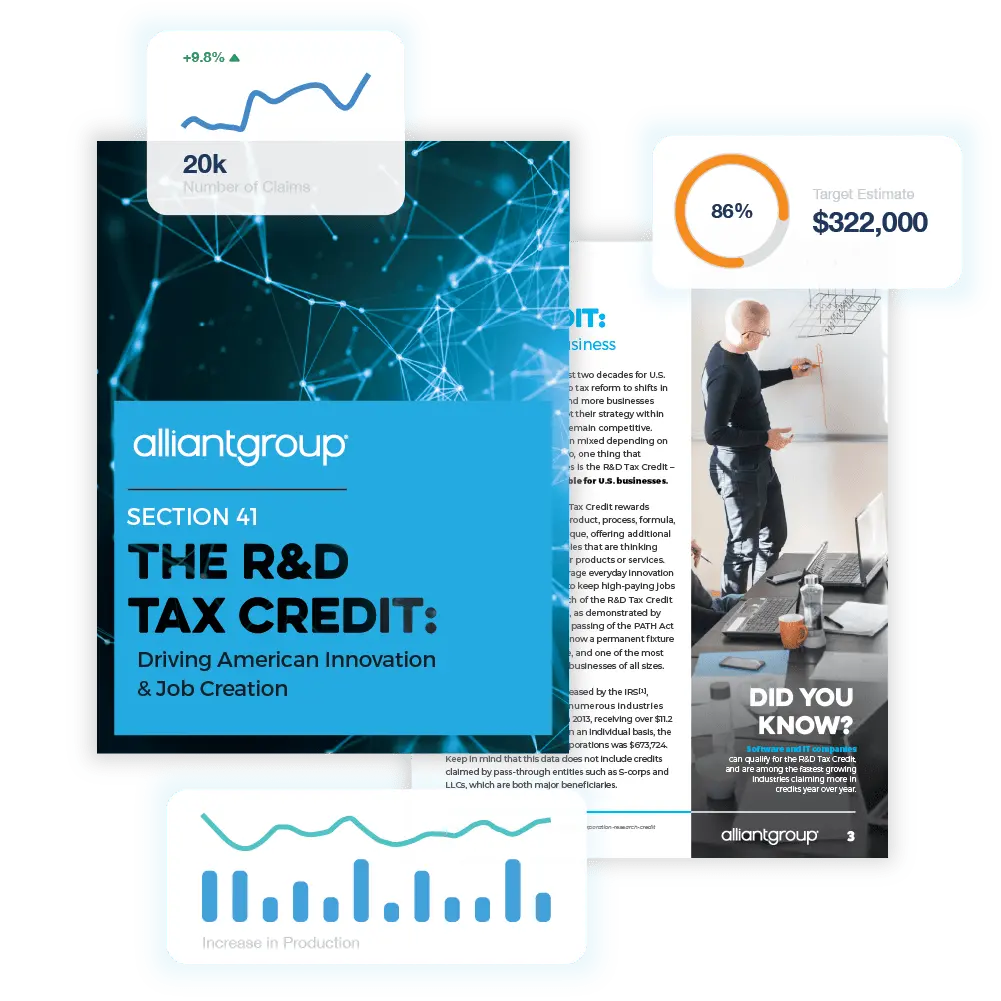What is the R&D Tax Credit?
The R&D tax credit is a federal incentive introduced in 1981 to increase technical jobs within the US and encourage businesses to invest in developing and using cutting-edge solutions. Today, it is the most powerful permanent incentive available to businesses, providing dollar-for-dollar tax reduction for developing, designing, or improving products, processes, formulas, or software.
Qualifying for this credit doesn’t require you to wear white lab coats or have scientists on board. In fact, industries ranging from manufacturing to agriculture can qualify for this credit through many of their day-to-day activities.
As the marketplace continues to intensify with the rise of AI, the R&D tax credit can serve as a powerful tool for businesses who want to adapt and transform.
Not sure if you qualify? Schedule a free consultation with our team of experts!

Who Qualifies for the Research & Development Tax Credit?
The R&D tax credit is available to businesses of any size involved in activities to develop, design, or improve products, processes, formulas, software, or techniques. These don’t need to be groundbreaking innovations – even incremental improvements qualify.
The Protecting Americans from Tax Hikes (PATH) Act of 2015 significantly expanded access to the R&D credit by making it permanent and opening new opportunities for small businesses and startups to benefit from this incentive. This legislation ensures that companies of all sizes, including those with limited tax liability or subject to AMT, can take advantage of the credit to support their innovation efforts.
The IRS uses a Four-Part Test to determine qualification
The work must aim to create new or improve existing business components – focusing on function, performance, reliability, quality, or cost reduction.
There must be uncertainty regarding the capability, methodology, or design at the project’s beginning. This means the success of the development effort cannot be known in advance.
Activities must involve systematic evaluation of alternatives through methods such as modeling, simulation, trial and error, prototyping, or other testing methods to eliminate technical uncertainty.
Activities must rely on principles of hard sciences – physical science, engineering, computer science, or biological science. The focus is on technical concepts rather than aesthetic or social sciences.
Success Stories From Our Clients
- Manufacturing
- Engineering
- Agriculture
- Architecture
- Software & Tech
Automotive Safety Manufacturer
ANNUAL REVENUE:
$17.2 Million
TOTAL CREDITS EARNED:
$1.2 Million
QUALIFICATIONS:
- Introducing new or improved efficiencies to a wide range of manufacturing operations
- Designing and developing automotive parts and components
- Conducting first-article test inspections and scrutinizing parts to maintain quality assurance
- Overcoming regulatory compliance challenges and exceeding safety requirements Designing and developing automotive parts and components
Design Control Systems
ANNUAL REVENUE:
$30 Million
TOTAL CREDITS EARNED:
$545,000
QUALIFICATIONS:
- Development of schematic drawings for integration of system components
- Design of electrical wiring and layout for installation of control system
- Design coordination and value engineering in plan-spec and design-assist projects. Design input through RFIs, ASIs, and change orders
- Sequencing of system operations
Electrical Contracting
ANNUAL REVENUE:
$38 Million
TOTAL CREDITS EARNED:
$450,000
QUALIFICATIONS:
- Value engineering
- Development of alternative means and methods
- Feasibility and constructability reviews
- Load and power analyses
- Building Information Modeling (BIM)
General Contracting
ANNUAL REVENUE:
$195,000
TOTAL CREDITS EARNED:
$460,000
QUALIFICATIONS:
- Evaluation of alternative means & methods as well as construction techniques
- Structure and facility plans for constructability
- Construction equipment development and improvement
- Integrating LEED and sustainable initiatives
- HVAC and electrical system coordination
Civil Engineering Firm
ANNUAL REVENUE:
$285 Million
TOTAL CREDITS EARNED:
$1.3 Million
QUALIFICATIONS:
- Ensuring bridge and highway design meet specific structural and drainage requirements
- Designing pavement, roadway, street design, and related infrastructure
- Developing innovative lateral force resistance systems for buildings
- Creating foundation and earthwork design for unique site conditions
- Designing retaining wall structures
Structural Engineering Firm
ANNUAL REVENUE:
$64 Million
TOTAL CREDITS EARNED:
$1.2 Million
QUALIFICATIONS:
- Improving acoustical qualities of structure
- Developing alternative water flow / plumbing systems
- Developing alternative electricity conduction systems
- Developing or improving lighting within a structure
- Improving or developing alternative ventilation for a structure
- Improving or determining alternative heating and cooling systems
- Determining alternative structural designDetermining alternative structural design
Agriculture Company
ANNUAL REVENUE:
$183 Million
TOTAL CREDITS EARNED:
$3.2 Million
QUALIFICATIONS:
- Hybridization or development of new strains of crops, plants, or livestock
- Implementation of precision farming techniques in an attempt to increase yield and/or production efficiency
- Experimentation with new or different fertilizers (organic etc.)
Architectural Firm
ANNUAL REVENUE:
$2.3 Million
TOTAL CREDITS EARNED:
$78,500
QUALIFICATIONS:
- Developing unique energy-efficient features
- Designing master plans
- Developing schematic designs
- Developing planning and elevation drawings
Architectural Firm
ANNUAL REVENUE:
$18 Million
TOTAL CREDITS EARNED:
$244,000
QUALIFICATIONS:
- Developing unique energy-efficient features
- Designing master plans
- Developing schematic designs
- Developing planning and elevation drawings
App Development Company
ANNUAL REVENUE:
$3 Million
TOTAL CREDITS EARNED:
$375,000
QUALIFICATIONS:
- Innovating software-defined networks
- Development of software for cloud integration – use of multiple cloud platforms
- Testing new software prototypes
- Development of software for cloud integration – use of multiple cloud platforms
Network Engineering Company
ANNUAL REVENUE:
$11 Million
TOTAL CREDITS EARNED:
$1.6 Million
QUALIFICATIONS:
- Development/implementation of OpenFlow networks
- Design, development or engineering of software and/or hardware platforms
- Prototyping mobile commerce platforms
- Development of digital relationship management software Integration with extant systems
To know more about the Manufacturing click here

Discover Your Business's Tax Credit Potential
Let our expert tax consultants evaluate your business activities and help you understand how this tax credit can genuinely benefit you.
What Are the Benefits of Claiming the R&D Tax Credit?
Financial Impact
- Dollar-for-dollar reduction in federal tax liability
- Improved cash flow for continued innovation
- Additional state tax benefits in over 30 states
Strategic Advantages
- Competitive edge in rapidly evolving markets
- Carryforward earned credits for up to 20 years
- Perform back studies to recognize unclaimed credits for open tax years (up to 3 years)
Recent Industries We've Served
Traditional “R&D” industries such as engineering and software development are only the tip of the iceberg for the types of companies who can claim the R&D Tax Credit. Other industries that can qualify for the credit include:
How Does the Research &
Development Credit Work?
The R&D tax credit is calculated based on a company’s qualified research expenses (QREs) and provides a percentage of these expenditures as a dollar-for-dollar tax credit. QREs typically encompass four main categories:
- Wages paid to employees conducting, supervising, or supporting qualified research activities
- Supplies and materials used in the research process
- Software and cloud computing costs related to development activities
- Contract research expenses (limited to 65% of actual costs) paid to third parties performing qualified research on the company's behalf

How to Claim the R&D Credit?
Claiming the R&D tax credit involves two key components: documentation and filing. Companies must maintain contemporaneous documentation of their research activities, including project records, employee time tracking, technical documentation, and financial records that link expenses to qualifying research projects.
The formal claim process requires completing IRS Form 6765 (Credit for Increasing Research Activities) and submitting it with the company’s annual tax return. Companies can also explore opportunities to claim credits for prior open tax years through amended returns if they discover previously unclaimed qualifying activities.
Recent changes to Form 6765 require the taxpayers to provide a basis for their qualifications, essentially highlighting how they arrived at the claimed credit value. While the process now requires more due diligence, working with experienced tax professionals can help ensure proper documentation and maximize the benefit while maintaining compliance with IRS requirements.

Experience the alliant Advantage
We are leading experts in tax credits and incentives. Since 2002, we have helped US businesses grow their operations and stay ahead of the competition. To date, we have delivered tens of billions in refunds to over 40,000 businesses.
1000+ INDUSTRY EXPERTS
Our professionals are veterans from nearly every industry and already know how your operations qualify.
No other firm offers professionals versed in your industry.
FORMER POLICYMAKERS
Our former policymakers’ deep understanding of tax law and its business applications puts them at the forefront of Section 174 discussions.
This enables us to offer clients advice that considers both current and future tax legislation.
5 FORMER IRS COMMISSIONERS
Our former commissioners are the preeminent experts on IRS policy and ensure our practices align with the newest guidance.
No other firm offers this level of oversight.
DISCOVER MORE
The R&D Tax Credit:
Driving American Innovation
& Job Creation
In this whitepaper, you will learn:
- Which industries and companies are benefiting the most from the R&D credit
- Why changes relating to laws, regulations, guidance, and court decisions have greatly expanded the number of companies that are eligible for the credit
- Why business owners and CPAs tend to overlook the R&D credit in their tax planning and why they need to include it

FAQ's
What qualifies for the research and development tax credit?
R&D tax credits apply to activities that develop or improve products, processes, software, techniques, or formulas. To qualify, work must be technological in nature, eliminate technical uncertainty, involve a process of experimentation, and aim to develop new or improved business components.
Is the R&D tax credit worth it?
Yes, R&D tax credits can provide significant returns on investment. Companies can receive a significant refund on qualified research expenses as a federal tax credit, with additional state credits available. For many businesses, this translates to hundreds of thousands of dollars in annual tax savings.
What costs can be claimed for R&D?
Eligible R&D expenses include:
- Employee wages for those directly involved in R&D
- Supplies and materials used in research activities
- Contract research expenses (65% of payments to contractors)
- Cloud computing costs related to R&D
- Prototype development costs
How far back can you claim R&D tax credits?
Companies can typically claim R&D tax credits for the current tax year plus the previous three tax years. This lookback period allows businesses to recover previously unclaimed credits, though documentation requirements must still be met.
Does alliantgroup work with CPAs to support tax credit compliance?
Yes, alliantgroup partners extensively with CPA firms to provide comprehensive R&D tax credit services. We work collaboratively with accounting professionals to ensure proper documentation, compliance, and maximum benefit for their clients while maintaining the highest professional standards.




